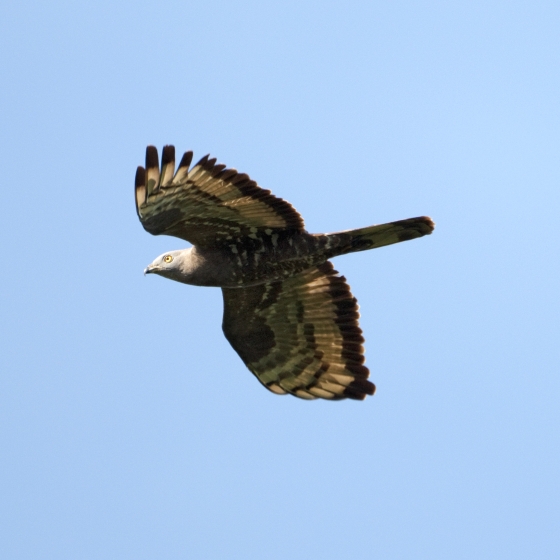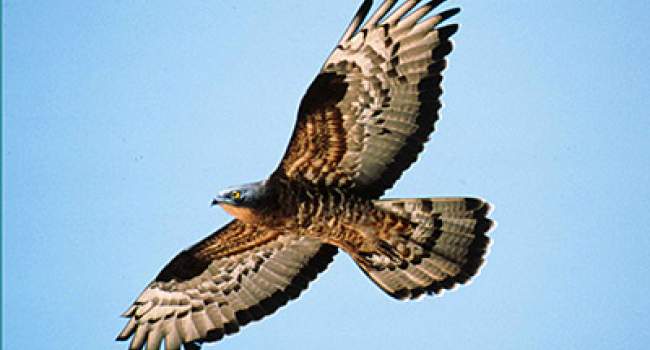Honey-buzzard
Pernis apivorus (Linnaeus, 1758)
HZ
 HONBU
HONBU  2310
2310

Family: Accipitriformes > Accipitridae

One of the UK's rarest breeding birds, Honey-buzzard is a raptor with a predilection for the grubs of wasp and bees.
While undoubtedly a rare breeding bird, the Honey-buzzard's preference for secluded mature woodland and secretive behaviour – spending relatively little time in the air – means that it is probably under-recorded.
Honey-buzzard is a summer visitor, whose wintering grounds lie to the south of the Sahara.
Identification
Honey-buzzard identification is often difficult. The following article may help when identifying Honey-buzzard.
Identifying Common Buzzard and Honey-buzzard

Buzzard is a familiar bird, but in summer and during migration time there is always the chance of finding a Honey-buzzard. Would you be confident in identifying it? Have a look at this guide to help you tell the difference.
SONGS AND CALLS
Listen to example recordings of the main vocalisations of Honey-buzzard, provided by xeno-canto contributors.
Begging call
Call
Develop your bird ID skills with our training courses
Our interactive online courses are a great way to develop your bird identification skills, whether you're new to the hobby or a competent birder looking to hone your abilities.
Browse training coursesStatus and Trends
Population size and trends and patterns of distribution based on BTO surveys and atlases with data collected by BTO volunteers.
CONSERVATION STATUS
This species can be found on the following statutory and conservation listings and schedules.
POPULATION CHANGE
The Honey-buzzard is a rare breeding species in the UK but the population and trend are unclear. Rare Breeding Birds Panel data give a mean of 38 breeding pairs for the period 2015–2019 and suggest that there has been a slight increase in the 25 years to 2019 (Eaton et al. 2021). The breeding estimate is likely to be low as it is a difficult species to monitor. A population estimate of 100–150 pairs was suggested by Roberts & Law (2014) and a national survey has recently been undertaken which may give a more accurate population estimate once the data have been analysed. The Bird Atlas data suggest the number of occupied squares may have increased since 1988–91, but this is uncertain as this may be due to improved levels of detection and reporting rather than a genuine increase (Balmer et al. 2013).
DISTRIBUTION
Honey-buzzard is a rare breeding species in the UK, with most records in southern England, plus Wales, north Yorkshire and Scotland.
More from the Atlas Mapstore.
Occupied 10-km squares in UK
| No. occupied in breeding season | 81 |
| % occupied in breeding season | 2.7 |
European Distribution Map
DISTRIBUTION CHANGE
| % change in range in breeding season (1968–72 to 2008–11) | +554.5% |
SEASONALITY
Honey Buzzards are localised summer visitor, mostly arriving from May onwards, with a pulse of migrants in September in some years.

Movement
Information about movement and migration based on online bird portals (e.g. BirdTrack), Ringing schemes and tracking studies.
An overview of year-round movements for the whole of Europe can be seen on the EuroBirdPortal viewer.
RINGING RECOVERIES
View a summary of recoveries in the Online Ringing Report.
Foreign locations of birds ringed or recovered in Britain & Ireland

Biology
Lifecycle and body size information about Honey-buzzard, including statistics on nesting, eggs and lifespan based on BTO ringing and nest recording data.
SURVIVAL & LONGEVITY
View number ringed each year in the Online Ringing Report
Maximum Age from Ringing 
|
12 years 11 months 21 days (set in 2018) 
|
Typical Lifespan 
|
9 years with breeding typically at 2 year |
Adult Survival 
|
0.86±0.013  
|
Juvenile Survival 
|
0.419 (to age 2) 
|
CODES & CLASSIFICATION
Ring size 
|
G |
Field Codes 
|
2-letter: HZ | 5-letter code: HONBU | Euring: 2310 |
For information in another language (where available) click on a linked name
Research
Interpretation and scientific publications about Honey-buzzard from BTO scientists.
CAUSES AND SOLUTIONS
Causes of change
As the trend is uncertain, it is also unclear what is driving the trend. Some studies suggest that they are highly successful breeders in the UK (Wiseman 2012) and hence productivity may be the demographic factor which is driving apparent increases.
Links to more studies from ConservationEvidence.com
- Breeding biology during establishment of a reintroduced griffon vulture Gyps fulvus population
- Comparison of the lethality of lead and copper bullets in deer control operations to reduce incidental lead poisoning; field trials in England and Scotland
- Growth and demography of a re-introduced population of white-tailed eagles Haliaeetus albicilla
Read more studies about Honey-buzzard on Conservation Evidence >
Would you like to search for another species?









Share this page